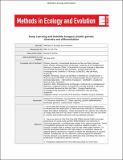Deep learning and satellite imagery predict genetic diversity and differentiation
Abstract
1. During the last decade, convolutional neural networks (CNNs) have revolutionised the application of deep learning (DL) methods to classification tasks and object recognition. These procedures can capture the key features of image data that are not easily visible to the human eye and use them to classify and predict outcomes with exceptional precision. 2. Here, we show for the first time that CNNs provide highly accurate predictions for small-scale genetic differentiation and diversity in Ctenomys australis, a subterranean rodent from central Argentina. Using microsatellite genotypes and high-resolution satellite imagery, we trained a simple CNN to predict local FST and mean allele richness. To identify landscape features with high impact on predicted values, we applied species distribution models to obtain the distribution of suitable habitat. Subsequent use of a machine learning algorithm (random forest) allowed us to identify the attributes that contribute the most to predictions of population genetic metrics. 3. Predictions obtained from the CNN accounted for more than 98% of the variation observed both in FST and mean allele richness values. Random forest regression on landscape metrics indicated that features involving connectivity and consistent prevalence of suitable habitat promoted genetic diversity and reduced genetic differentiation in C. australis. 4. Validation with synthetic data via simulations of genetic differentiation based on the landscape structure of the study area and of a nearby area showed that DL models are able to capture complex relationships between actual data and synthetic data in the same landscape and between synthetic data generated under different landscapes. 5. Our approach represents an objective and powerful approach to landscape genetics because it can extract information from patterns that are not easily identified by humans. Spatial predictions from the CNN may assist in the identification of areas of interest for biodiversity conservation and management of populations.
Citation
Kittlein , M , Mora , M S , Mapelli , F J , Austrich , A & Gaggiotti , O E 2021 , ' Deep learning and satellite imagery predict genetic diversity and differentiation ' , Methods in Ecology and Evolution , vol. Early View . https://doi.org/10.1111/2041-210X.13775
Publication
Methods in Ecology and Evolution
Status
Peer reviewed
ISSN
2041-210XType
Journal article
Description
Funding: Financial support was provided by Consejo Nacional de Investigaciones Científicas y Técnicas (CONICET, PIP 11220150100066 CO), UNMdP (Project EXA903457/18) and FONCYT (PICT 201-0427).Collections
Items in the St Andrews Research Repository are protected by copyright, with all rights reserved, unless otherwise indicated.

